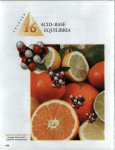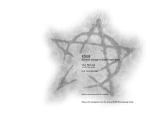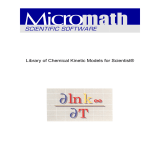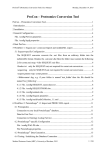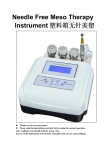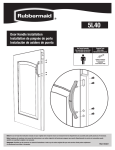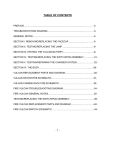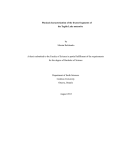Download Buffer Bench - University of Connecticut
Transcript
Buffer Bench Buffer Theory and User’s Manual Table of Contents 1. Introduction . . . . . . . . . . . . . . . . . . . . . . . . . . . . . . . . . . . . . . . . . . 1 2. Program Features . . . . . . . . . 1. Interface. . . . . . . . . . . 2. Adaptable buffer choices . . 3. Ionic strength correction.. . 4. Inclusion of additional salt . 5. Graphics Panel . . . . . . . 6. Data exportation . . . . . . 7. Buffer quality ranking . . . . . . . . . . . . . . . . . . . . . . . . . . . . . . . . . . . . . . . . . . . . . . . . . . . . . . . . . . . . . . . . . . . . . . . . . . . . . . . . . . . . . . . . . . . . . . . . . . . . . . . . . . . . . . . . . . . . . . . . . . . . . . . . . . . . . . . . . . . . . . . . . . . . . . . . . . . . . . . . . . . . . . . . . . . . . . . . . . . . . . . . . . . . . . . . . . . . . . . . . . . . . . . . . . . . . . . . . . . . . . . . . . . . . . . . . . . . . . . . . . . 1 2 3 3 3 3 4 4 3. Buffer Theory. . . . . . . . . . . . . . . . 1. The pH scale . . . . . . . . . . . . . 2. The Henderson-Hasselbach equation 3. Mole fraction . . . . . . . . . . . . . 4. Ionic strength . . . . . . . . . . . . . 5. Buffer capacity . . . . . . . . . . . . . . . . . . . . . . . . . . . . . . . . . . . . . . . . . . . . . . . . . . . . . . . . . . . . . . . . . . . . . . . . . . . . . . . . . . . . . . . . . . . . . . . . . . . . . . . . . . . . . . . . . . . . . . . . . . . . . . . . . . . . . . . . . . . . . . . . . . . . . . . . . . . . . . . . . . 4 5 5 6 7 8 4. Calculation assumptions . . . . . . . . . . . . . . . . . . . . . . . . . . . . . . . . . . . 8 5. Acknowledgements . . . . . . . . . . . . . . . . . . . . . . . . . . . . . . . . . . . . . . 9 6. References . . . . . . . . . . . . . . . . . . . . . . . . . . . . . . . . . . . . . . . . . . 9 About this program The Buffer Bench program and manual were written by Matthew J. Ranaghan. The program was created by using REALbasic 2007 Release 4 for Mac OS X (Version 10.5). Contact email: [email protected] Mailing Address: University of Connecticut Molecular & Cell Biology Department 91 North Eagleville Road Storrs, CT 06269 Written for Buffer Bench Version 2 Copyright University of Connecticut i 1. Introduction Buffers are an integral part of life. Biological reactions are optimized to function at a specific pH, which is maintained by naturally occurring buffers within organisms. The binding of molecular oxygen to the Haem moiety of Haemoglobin, a vital reaction for all multicellular eukaryotic organisms, is the best-known example (1). In fact, selecting the proper buffering system is a critical consideration for a vast array of fields that includes, but is not limited to: medicine, pharmaceuticals, agriculture, analytical chemistry, environmental chemistry, and biochemistry. The motivation for creating this program is a result of the arduous nature of conducting buffer calculations and determining whether the molecular system is useful for the desired application. The conventional method for making buffers is to choose a molecule with a pKa + 1 unit of the desired experimental pH; however, this value is subject to correction by the ionic strength of the buffer (2, 3), a consideration that is often overlooked. Thus, the major benefit of using the Buffer Bench program is the ability to calculate and view the buffering environment with or without the correction of the ionic strength. The theory, considerations, and process for conducting these calculations are described in the subsequent sections. 2. Program Features Buffer Bench is a program that calculates several general parameters of a buffer system and determines whether the buffer is useful by the given input. These calculations require minimal information, see Fig. 1, and allow the user to fine tune the desired buffer with nominal effort. The major feature of this program, however, is the ability to quickly and efficiently conduct buffer calculations with or without correction of the innate ionic strength. Other features of this program include: • Simple interface • Adaptable buffer choices • Inclusion of additional salt • Graphics panel • Data exportation • Buffer quality ranking 1 Figure 1: The Buffer Bench program interface. 2.1 Simple interface Buffer Bench is designed to present the user with the calculated data after setting the desired buffer parameters. These parameters are grouped in the top left corner of the program (figure 1) and preset with values of a general buffer system. Prior to conducting a calculation, the user must select a buffer system, via the Buffer Molecule… menu, and a calculation type, via the Calculation Options… menu, for display in the Graphics panel. Each menu option is individually discussed in the sections below. After a calculation is run, a summary of the data is presented in one of three tabs that are then unlocked. The Buffer Info tab displays all of the calculated information for the set parameters. This information includes the corrected ionization constant(s) (pKa; see section 3.4), an analysis of the buffer quality (see section 2.7), a summary of the entered and calculated buffer parameters, and the buffer recipe. The Plot Data tab contains the data for generating the buffer profile, which is plotted in the Graphics panel. The Graphics panel displays the pH profile, from pH 0 to 14, for the method selected in the Calculation Options… menu and must be refreshed, via the Calculate! button, before the image will change. 2 2.2 Adaptable buffer choices The user is able to enter a novel buffer molecule by selecting the Other… option in the Buffer Molecules… menu. This option unlocks the three pKa editfields and the editfield for entering the net charge of the molecule at pH zero. A maximum of three pKa values can be entered for a given calculation, but only one value is required for Buffer Bench to work. The user must also know the relative net charge of the molecule at pH 0 to give the program a reference point. The default value of the latter variable is zero. 2.3 Ionic strength correction This option is the main feature of Buffer Bench and allows the user to quickly calculate the buffer characteristics with correction of the innate ionic strength. The theory and explanation of this correction are found in section 3.4 of this manual. The program default includes this correction, but the user can easily override the function by deselecting the checkbox above the Calculate! button. 2.4 Inclusion of additional salt The user has the option to include additional salt (i.e. NaCl) in the buffer if a greater ionic strength is desired while using less buffer molecule. Ionic strength effects are known to be significant in some protein systems (e.g. ligand binding, protein stability) and the addition of NaCl to a buffer are not uncommon. Ergo, the program includes this value in the calculations when changed from the default value of zero. 2.5 Graphics panel The calculation generates a static profile, which is only valid at the set pH, from pH 0 to 14 in the Graphics panel. This plot represents the Mole Fraction, Ionic Strength, or Buffer Capacity calculation that is set in the Calculation options… menu. Although this profile is only valid at the set pH, it provides insight on how the system is able to adapt to pH fluctuations. The corresponding data is printed in the Plot Data tab and is easily copied or exported by the user for plotting in other programs (e.g. Excel, Mathscriptor). Details for exporting the data is described in section 2.6. 3 2.6 Data exportation Buffer Bench offers two save options: raw data and graphics. The raw data is exported as a tab delimited file when the user selects the Save Data… button. The user should note that this data correlates with the data that is both selected in the Calculation Options… menu and displayed in the Graphics panel. This data file also includes the buffer summary from the Buffer Info tab as the file header and is easily imported into any graphics program. The second save option, the Save Image… button, allows the user to save the buffer profile image as a JPEG, JPEG 2000, Photoshop, MacPaint, Pict, PNG, Quicktime, SGI, TIF, Truevision, or Windows BMP image. The user also has the option of saving the graphics image as a high resolution JPEG by concomitantly holding the option button and pressing the Save Image… button. 2.7 Buffer quality ranking Buffer Bench assesses the relative usefulness of a calculated buffer as the deviation from the closest (un)corrected pKa value (figure 2). This feature simplifies the optimization process of tailoring a buffer for an experiment. This system, although generic, is appropriate for all applications where the desired pH is close to the experimental pKa. Figure 2: Method for ranking the quality of a theoretical buffer with a pKa of 7.0. 3. Buffer Theory By definition, a buffer is comprised of any molecular system that is able to accept or donate a proton to avoid a pH fluctuation in the environmental milieu. The pH is defined as the negative log of the hydrogen ion concentration, which is shown in equation 1: pH = " log[H + ] (1) The buffering system can be either acidic or basic, but must be selected carefully to match the needs of the desired application. The pKa, or the ionization constant of the proton, ! is a useful value for making buffers and many such values (e.g. Good’s biological buffers, 4 Figure 3: The pH scale with select examples of common biologically relevant chemicals (4). phosphate) are published (5, 6). For clarity, explanation of underlying theory for this program has been broken up into several sections and each is described below. 3.1 The pH scale The pH scale, shown in Fig. 3, is based on the ionization of water. H 2O " H + + OH # At standard temperature and pressure, this ionization results in a concentration of 10-7 M protons and 10-7 M hydroxide ions. ! dissociation constant of water (KW): The product of these ionized species defines the K w = [H + ][OH " ] (2) K w = [10 "7 M][10 "7 M] (3) K w = 10 "14 M (4) ! and the negative logarithm ! of Eq. 2 defines the pH scale (equation 6): [ ] [ + " !" logK w = " log H " log OH ] pH + pOH = 14 (5) (6) which is shown in Fig. ! 3. ! 3.2 The Henderson-Hasselbach equation Functional buffers are calculated using the Henderson-Hasselbach equation (7). This analysis, which is derived below, is based on the known pKa value of ionization. The pKa is the pH where the conjugate acid ([HA]; M) and conjugate base ([A-]; M) species are in equilibrium. Figure 4 represents the chemical equilibrium of acetic acid ionization. The ionization constant of this chemical equation is mathematically defined as: 5 Figure 4: Chemical equilibrium reaction of acetic acid (conjugate acid) and the acetate ion (conjugate base) in a theoretical buffer solution. The hydronium ion (H3O+) is used to represent the aqueous free proton population. The pKa of acetic acid is 4.76. [H + ][A " ] Ka = [HA] (7) and is rearranged to solve for the aqueous proton concentration : # [A " ] & [H ] = K a % ( $ [HA]' ! + (8) Equation 8 is then substituted into Eq. 5 and rearranged to solve for the HendersonHasselbach equation: ! # [A " ] & pH = pK a + log% ( $ [HA]' (9) 3.3 Mole Fraction ! Statistical treatment of a buffering molecule simplifies the mathematical analysis of buffer systems (8, 9). The mole fraction, or ratio of the chemical species present as compared to the total moles, satisfies this requirement (figure 5). Note that the mole fraction represents an approximation of the statistical profile, throughout the pH scale, as a function of the pKa. For the monoprotic acetic acid example, shown in Fig. 4, the mole fraction of the conjugate acid is derived from the mass balance: 1 = [HA] + [A " ] (10) Figure 5: Mole fraction of conjugate acid (black) and conjugate base (red) species of acetic acid. ! 6 1 [HA] [A " ] = + [HA] [HA] [HA] (11) and then solved for the Henderson-Hasselbach equation (9): 1 = 1 + 10( pH " pK a ) [HA] ! 1 [HA] = ( pH " pK a ) 1 + 10 ! The conjugate base is then derived by the same method to yield: [A " ] = ! (12) 1 % # C $ 10 pH " pK a & HA (13) (14) The program is also equipped to handle diprotic and triprotic buffers. The derivation of such systems, however, is analogous to the above example. ! 3.4 Ionic Strength The ionic strength (IC) of the buffer is an essential, but often overlooked, component. The effect of this component to the experimental pKa is demonstrated for a phosphate buffer in Fig. 6. Buffer Bench provides the user with an option to calculate the theoretical buffer profile, by ignoring the ionic strength effects (see section 2.3), or correct the experimental pKa via the Debye-Huckel limiting law: pK a * = pK a " 1.824 x10 6 z+ z" IC (#T) 3 / 2 (15) where pKa* is the IC corrected pKa value, ε is the dielectric constant of the solution (78.54 F m-1 for water at 298!K), T is the temperature (K), z is the charge of the positive or negative ion and IC is the ionic strength (M) (2, 3). The IC is calculated from the mole fraction via: n IC = 1 2 " c i zi 2 i=1 (16) where ci is the concentration of the aqueous ion (M) and zi is the charge of the ion. ! 7 The user should be aware, however, that the ε of Buffer Bench is currently parameterized for dilute aqueous solutions and may not be reliable with highly ionic buffers. Hence, under such situations, the user may have to manually adjust the buffer pH to correct for unaccounted changes of the dielectric medium. Alternatively, the user is able to Figure 6: The second pKa of a phosphate buffer at pH 7.0 as it is corrected for increasing ionic strength. Correction of the experimental pKa was conducted with Eq. 15. deselect the Ionic Strength Correction checkbox to calculate the theoretical values of the desired buffer system and perform their own correction if the appropriate ε is known. Such a feature is desired and will be incorporated into future versions of the program. Regardless, the program efficiently calculates a suitable approximation of the desired buffering and allows the user a unique ability to tailor a system for any experiment. 3.5 Buffer Capacity The buffer capacity (βC) is a measure of the chemical stress, whether from acid or base, that the buffer system can handle before undergoing a pH change (figure 7). The general form for calculating the βC is: + % N #1 % N (( . 2 "C = 2.303-CB ' $ f j ' $ (ñ # j ) f n * * 0 ) ) 0/ -, & j =0 & n = j +1 (17) where CB is the total buffer concentration (M), fj is the mole fraction of the jth ! species, and ñ is the average number of bound protons per buffer molecule (8). Details of the derivation for Eq. 17 are found in the cited reference. Figure 7: Buffer capacity profile of a 0.1 M acetic acid buffer (pH 5.0). 8 4. Calculation assumptions • Buffer Bench works best for dilute buffers with low to modest ionic strength. The program works moderately well with high ionic strength buffers, such as phosphate, but some adjustment may be required to set the final buffer pH. • Stochiometric, rather than thermodynamic, treatment of buffering molecules is used. • The ionic strength correction factor (see section 3.4) is parameterized for dilute aqueous buffers. • Dilution effects are neglected. • The buffer profile, displayed in the Graphics panel, represents the profile at the calculated pH and is only meant to give the user insight towards buffer adaptability. 5. Acknowledgments I would like to thank Dr. Robert R. Birge for his tutelage and continual support of my programming abilities. Without his guidance and expertise, I would not have been capable of creating Buffer Bench or any other programs used throughout my research career. I would also like to thank Connie Birge, Michelle Y. D. Ranaghan, Daniel Sandberg, Megan Sandberg and Nicole Wagner for their comments and recommendations for making this program more useful. Furthermore, I would be remiss without thanking Dr. Linda McCollam-Guillani, Sierra Drevline, and Nathan Rheault for their help in troubleshooting the functionality of the program from the beginning. 6. References (1) Stryer, L. (1995) Biochemistry, 4 ed., W. H. Freeman, United States. (2) Debye, P., and Hückel, E. (1923) The theory of electrolytes. I. Lowering of freezing point and related phenomena. Phys. Z. 24, 185-206. (3) Chang, R. (2000) Physical Chemistry for the Chemical and Biological Sciences, 3 ed., University Science Books, Sausalito, CA. (4) McWilliams, M. (2008) Foods: Experimental Perspectives, 6 ed., Pearson Prentice Hall. (5) Windholz, M. (1983), Merck&Co., Inc., Rathway, N.J. (6) Good, N. E., Winget, G. D., Winter, W., Connolly, T. N., Izawa S., and Singh, R. M. M. (1966) Hydrogen Ion Buffers for Biological Research. Biochem. 5, 467-77. (7) Henderson, L. J. (1908) Concerning the relationship between the strength of acids and their capacity to preserve neutrality. Am. J. Physiol. 21, 173-9. (8) Asuero, A. G. (2007) Buffer Capacity of a Polyprotic Acid: First Derivative of the Buffer Capacity and pka Values of Single and Overlapping Equilibria. Crit. Rev. Anal. Chem. 37, 269-301. (9) Riulbe, H. (1993) On the use of dimensionless parameters in acid-base theory. II. The molar buffer capacities of bivalent weak acids and bases. Electrophor. 14, 202-4. 9












